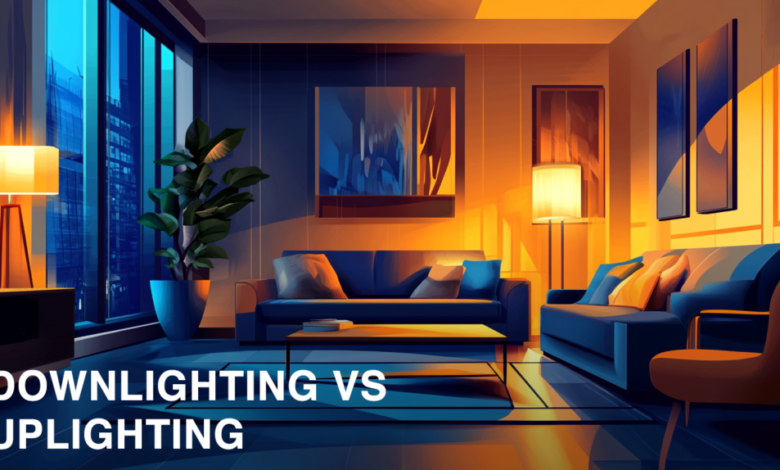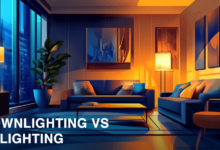Downlight vs Uplight: Choosing the Perfect LED Lighting for Your Space

Lighting plays a crucial role in shaping the ambiance and functionality of any space. Whether you’re illuminating a cozy living room or enhancing a modern office, the type of lighting you choose can significantly impact the environment. When considering lighting options, two popular choices come into play: downlight vs uplight. Understanding the differences between these two types of lighting is key to selecting the right solution for your space.
As a leading LED lighting manufacturer, Vorlane specializes in providing innovative and high-quality LED lighting solutions tailored to a wide range of needs. With their experience in co-branding partnerships and technological advancements, Vorlane’s offerings, such as private model customization and high certification standards, cater to global distributors, engineers, architects, and designers. This article will explore the distinctions between downlight vs uplight and guide you in choosing the perfect lighting for your home or office.
What Are Downlights and Uplights?
Downlights are fixtures that direct light downward, typically installed into ceilings. These lights are designed to provide focused, task-oriented illumination, making them ideal for areas that require more concentrated lighting, such as kitchens, bathrooms, or offices. Downlight vs uplight essentially refers to the direction in which light is cast. Downlights provide clear, direct light, often used for ambient or general lighting as well, offering a sleek, unobtrusive solution for modern spaces.
On the other hand, Uplights are designed to shine light upwards, illuminating walls or ceilings. These lights are commonly placed on the ground or angled against a surface to highlight architectural features or create an ambient glow. Uplights are perfect for spaces where a softer, more atmospheric light is desired, such as living rooms, galleries, or outdoor spaces.
Both types of lighting serve different purposes and can transform the look and feel of a room. While downlight vs uplight varies in terms of lighting direction, both contribute significantly to the overall lighting scheme.
Advantages of Downlighting
Downlighting is widely appreciated for its ability to provide clear, direct light. It is especially effective for task lighting, where visibility and focus are essential. Whether you’re chopping vegetables in the kitchen or reading a book in the living room, downlights deliver the right amount of light to help you complete tasks with ease. Since downlights are usually recessed into the ceiling, they offer a clean, minimalist look that complements various interior styles.
Another advantage of downlights is their ability to minimize glare. Because the light is focused downward, it ensures even light distribution without harsh shadows or discomfort. For areas requiring bright, focused light, such as workspaces or corridors, downlights are the perfect option.
By using Vorlane’s LED downlights, you can benefit from energy-efficient solutions that provide long-lasting, high-quality lighting. Vorlane’s advanced LED technology ensures that your downlights are not only effective but also sustainable, offering significant energy savings over traditional lighting options.
Advantages of Uplighting
Uplighting creates a completely different atmosphere, perfect for spaces that prioritize ambiance over direct task lighting. By casting light upwards, uplights can soften a room’s overall illumination, creating a welcoming and warm environment. Uplights are ideal for highlighting architectural features such as columns, textured walls, or even artworks. This type of lighting is also commonly used in landscape design, where it can highlight trees, sculptures, or water features.
One of the key benefits of uplighting is its ability to make a room feel more expansive. Uplights can visually raise ceilings and create the illusion of a larger space, which is particularly beneficial in smaller rooms or rooms with low ceilings. Additionally, uplights can complement the existing lighting in a room, providing indirect light that enhances the room’s mood without overpowering the environment.
Vorlane’s LED uplights are designed to be both functional and aesthetically pleasing. Their customizable uplights allow you to choose from various models to fit your specific needs, whether you’re lighting up an indoor feature or adding accent lighting to your garden.
How to Choose Between Downlighting and Uplighting
When deciding between downlight vs uplight, consider the purpose of the room and your lighting goals. If you’re looking for bright, functional lighting that enhances visibility for tasks like cooking, reading, or working, downlighting is the clear choice. It’s a more practical solution that provides focused, direct illumination, ensuring you can complete tasks with ease.
On the other hand, if your goal is to create an inviting, relaxing atmosphere, uplighting is an excellent option. It can add warmth to a room, highlight architectural features, and provide indirect lighting that softens the overall ambiance.
In many cases, a combination of both downlight vs uplight is the best option. By layering the two, you can create depth and dimension in your space. For example, using downlights for task areas and uplights to accentuate a feature wall can result in a balanced, harmonious lighting scheme.
Why Vorlane is Your Ideal LED Lighting Partner
As a global leader in LED lighting solutions, Vorlane offers an extensive range of products designed to meet the unique needs of distributors, engineers, architects, and designers. Vorlane’s commitment to quality and innovation is evident in its high certification standards, ensuring that every product meets the highest industry requirements for safety and reliability.
Vorlane also offers private model customization, allowing clients to personalize their lighting products to match specific project requirements. Whether you’re looking to create a custom lighting scheme for a corporate office or add bespoke features to your home, Vorlane’s expertise in co-branding partnerships and technological advancements makes them the ideal partner for your next lighting project.
By choosing Vorlane, you’re not just investing in superior lighting; you’re gaining access to cutting-edge technology that enhances both functionality and aesthetics in any space.
Conclusion
Choosing the right lighting can drastically change the look and feel of a space. Whether you opt for downlights for focused task lighting or uplights for ambiance and architectural enhancement, both types offer unique benefits. By understanding the key differences between downlight vs uplight, you can make an informed decision that aligns with your design goals.
With Vorlane as your lighting partner, you can ensure that your lighting choices are both innovative and high-quality. Vorlane’s energy-efficient LED solutions, along with their customizable options and commitment to excellence, make them the go-to manufacturer for lighting solutions worldwide.
FAQs
- What is the primary difference between downlights and uplights?
Downlight vs uplight primarily refers to the direction in which light is cast—downlights shine light downward, while uplights project light upward. - Can downlights and uplights be used together in a single space?
Yes, combining both types of lighting allows you to create depth and dimension, with downlights providing task lighting and uplights enhancing the room’s mood. - Why should I choose Vorlane for LED lighting solutions?
Vorlane offers innovative, energy-efficient LED lighting products with high certification standards, customization options, and global co-branding expertise. - Are LED downlights energy-efficient?
Yes, LED downlights are highly energy-efficient and can provide long-lasting, high-quality illumination while significantly reducing electricity consumption. - What are the benefits of uplighting in outdoor spaces?
Uplights are perfect for highlighting trees, sculptures, or water features in gardens, adding depth and creating a dramatic effect while enhancing outdoor ambiance.
